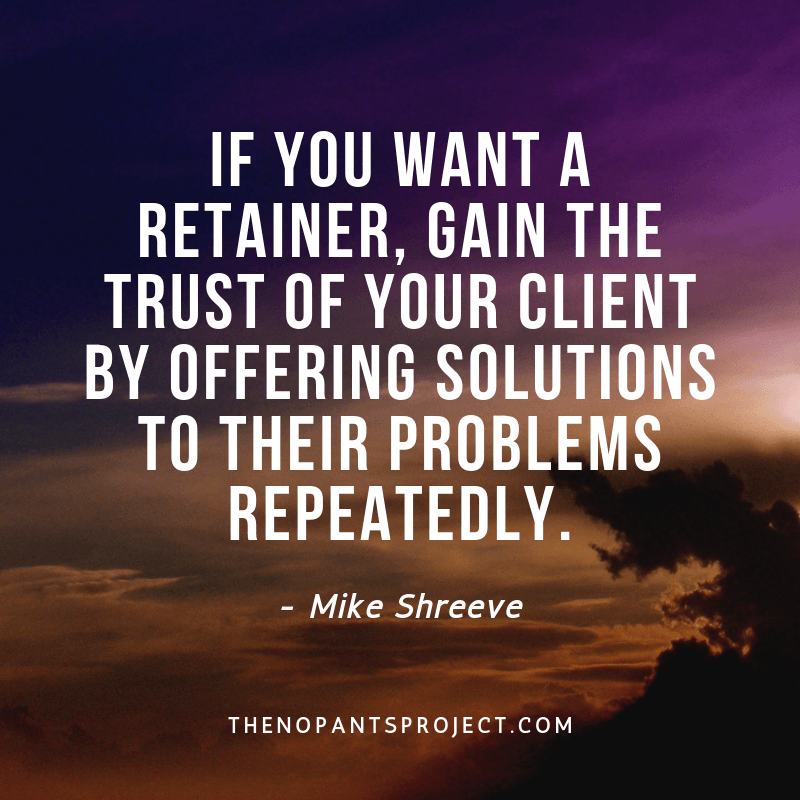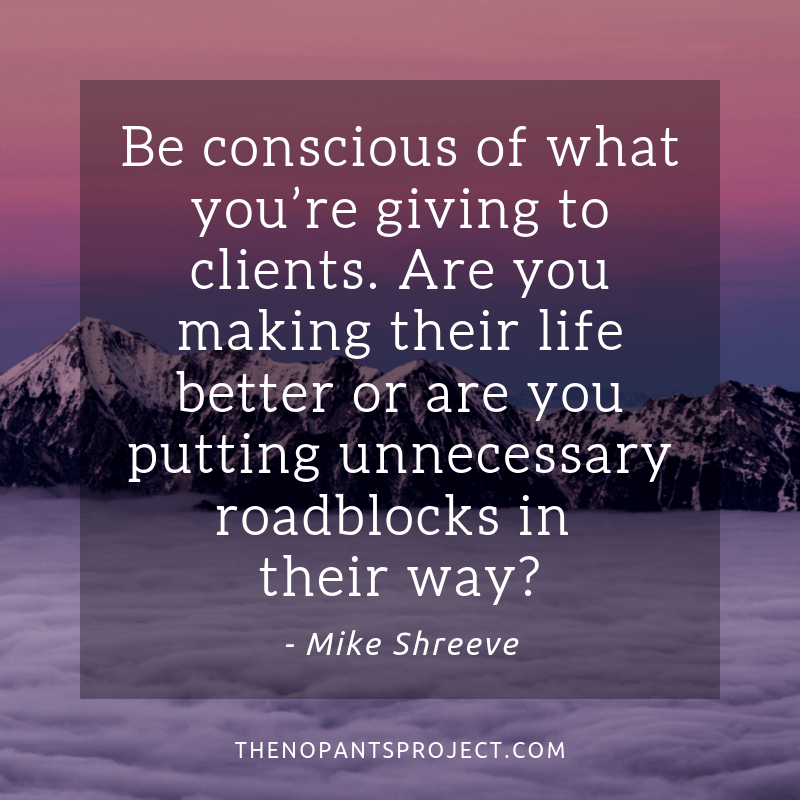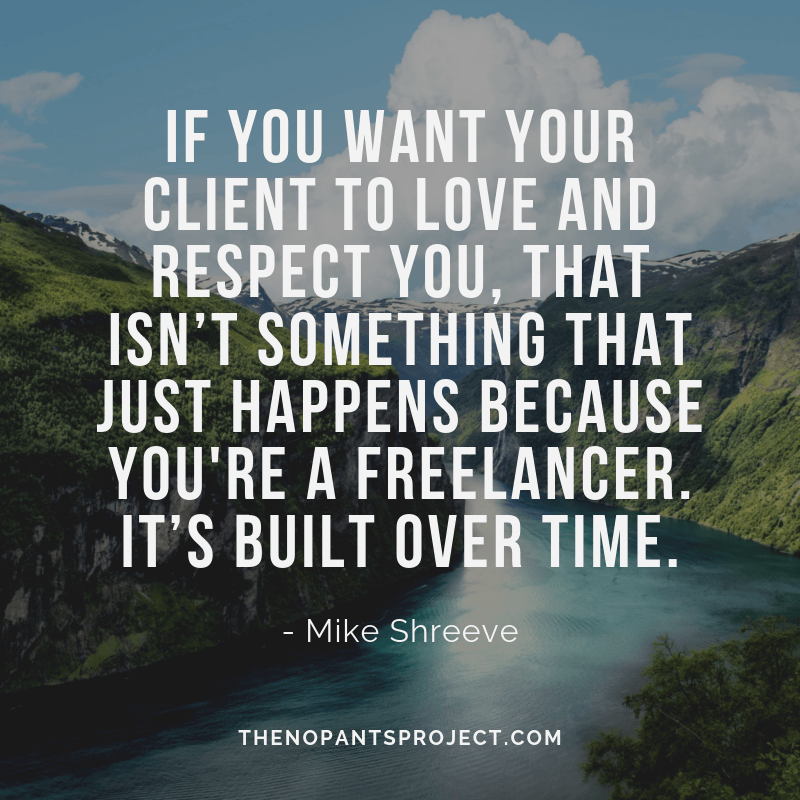Listen to this Podcast:
Listen on Anchor Listen on Spotify Listen on Apple Podcasts Listen on Google Podcasts
SUMMARY
- In this video, Mike Shreeve of The No Pants Project shares four easy ways to provide more value to your clients as a freelancer. This isn’t about technical skill, but about improving relationships and creating win-win situations so that you can establish long-term relationships and move into the retainer zone with your clients.
- What you’re about to learn are very simple concepts, but very few people actually do them. So even if you do just a couple of these things, you’ll find yourself moving ahead of the pack quickly. You’ll be able to build a referral network, develop a reputation, and increase the level of clients that you work with in no time.
- #1: 80/20 Your Clients
The 80/20 rule states that 80 percent of your results come from 20 percent of the things you do. As a freelancer, start thinking about how you can be more mindful to your clients’ 80/20. Are you making their life better or are you putting unnecessary roadblocks in their way? - For example, if you’re an email copywriter and you send the emails to your client in a Word document but they don’t have a team to upload those emails to an autoresponder sequence, then you’ve just given them something outside of their 80/20 zone. If there are little things like that, you can just do them for your client instead of “assigning” stuff back to them.
- #2: Deadlines
Most clients don’t have large project management teams or have any idea how to properly deal with deadlines. Reduce stress for everyone by assuming your client is horrible at deadlines and making sure that you preempt the deadline. Don’t wait until the actual deadline to turn in your deliverables; give it to them earlier. - #3: Problem/Solution/Responsibility
There is way more work available to you right now with the clients you have than you could ever go get somewhere else. If you see a problem that your client isn’t addressing, tell them about it, then offer solutions and take responsibility for it. This is where most freelancers fail—while they’re good at noticing and stating problems, they rarely do anything about it, thus adding more things to their client’s plate. - Solving your client’s problems is the yellow brick road to retainers. Do this repeatedly and they’ll start to see you as more than just a cog in the machine. Clients will pay for retainers when they know that you will take the initiative. There’s no incentive to move to a retainer if a freelancer only does exactly what they say they’re going to do.
- #4: Emotional Consistency
One of the worst things that you can do is to have your client make adjustments for whatever’s going on emotionally with you. Keep in mind that clients are also human beings and have emotional stuff of their own to deal with. - A sign of emotional consistency is the ability to maintain forward momentum regardless of changes. Many clients are so overwhelmed with other relationships and things going on that emotional inconsistency can kill projects. That said, most of them want to care about their people, but they don’t have the time or ability to be your personal counselor.
HOT NEWS & DEALS
- Free Training! The No Pants Workshop
For anyone serious about owning their own successful (yet flexible) business. Learn how to quit your job and leverage your talents to live the ultimate freelancer freedom lifestyle! Register now for this free training to learn the 3-step plan to Full-Time (Profitable) Freelancing. - Free Client-Getting Email Templates For Freelancer Writers!
If you are a freelance writer (or you’d like to be!), download these FREE client-getting email templates. Mike has used these EXACT templates to land monthly retainers for his writing services, get featured in top shelf magazines (as a nobody), and land some of the biggest names in his dream industry as clients without spending a penny in advertising or marketing… - Download ‘The Anti-Commodity Formula’ Workbook!
Learn how to attract your ideal clients and customers, charge more than your competition, and build a business from a home that you love.
INSPIRATIONAL QUOTES


FULL TRANSCRIPT: 4 Ways To Add Value To Clients
Hey everybody, Mike Shreeve here. Welcome to this discussion. We’re going to be talking about a couple of easy ways to add value to clients.
This is not anything to do really with technical skill. I think a lot of people overvalue technical skill. This is really going to be about how do I improve relationships, how do I create for clients and myself, for lack of a bit more original term, a win-win situation so that we can develop long-term relationships, so we can move into the retainer zone?
What are the little tricks and tips that allow you to add that little extra value that other freelancers aren’t adding, that other service providers aren’t adding, that allows you to stand out from the crowd?
And when the client is sitting there and they’re looking at all the different options of who can I hire, and who’s going to stay on the team, and who am I going to get rid of, that you are always in the safe zone.
These are very simple concepts, but I would say in the world of freelancing, so few people do these, that if you do, let’s say, half of them, you don’t have to do all four, you are going to move very quickly in building a referral network, in developing a reputation and in being able to quickly increase the level of clients that you work with.
1. 80/20 Your Clients
All right, so number one is what I call 80-20 your clients. So for those of you who aren’t familiar, we talk a lot about this. But 80-20 is simply 80% of your results come from 20% of the things you do.
Therefore, what you ought to do as a freelancer is sit down and look at what are all the things that I do, what 2 out of 10 or 1 out of 5 things that I do every single day that are actually contributing most of my gains, most of my financial success, most of my client getting success, etc?
What are those things that are actually contributing?
Let me get rid of everything else so that I can focus on just those, life is more simple, more time, etc., etc.
Now, we always talk about The No Pants Project, but how you do that for yourself as a freelancer, as a service provider?
What I want you to start to begin thinking about is how can I be more mindful about my contribution to my clients’ 80-20?
Let me give you an example.
I got an email yesterday or today from one of my freelancers. We had some back and forth. So I’m the client in this situation, working with a freelancer, the freelancer says to me… basically, something was coming up on our social media. It wasn’t posting properly, it wasn’t working properly. We were going back and forth and having a discussion about what are some of the possible solutions, how can we get this solved, and the freelancer says to me, “Okay, well, if you want to go ahead and delete that post from that social media platform, you can go ahead and do that.”
Now, I don’t think that this was meant maliciously. So I just want to be perfectly clear. I didn’t take it maliciously either. I don’t think that this particular freelancer was thinking about it when they sent it. I think they were just like, “Okay, we’ll delete it then if you don’t… just like, “Okay, cool. That’s the deal, and we’ll just delete it.”
And I think many freelancers do this to their clients. They’re so focused on what their sort of what they believe their deliverable is that they are not conscious of how they are influencing the 80-20 of a client.
Now, let me give you this specific rundown here.
So I run a seven-figure business and two high six-figure businesses. This isn’t about arrogance, this is about my 80-20. So the Mike Shreeve 80-20 it’s not a good use of time for me to go into a social media account, login, delete something, format, tweak it, etc.
That means that the freelancers ask… because, for example, I could be creating content, I could be coming up with ideas, I could be… there’s a million different I can be making videos like this. There’s a million different things I could be doing instead of what is essentially a virtual assistant level task.
So I think oftentimes as freelancers, we forget that there’s a back and forth exchange of client assigning stuff to you and then you assigning stuff back to clients.
Let me give you another example.
If I’m a copywriter, and I’m writing emails for a client, and I send the emails in a word document, let’s say, pretty standard, a lot of copywriters do that, and the client doesn’t have a team to upload those emails into something like an active campaign or a MailChimp or some kind of autoresponder sequence, then we as the freelancer have literally just given the client something outside of their 80-20 zone. So we are contributing to devaluing the time of our client.
So again, easy ways to add massive value to your client, if there’s little things like that, you can just do them. Like this particular freelancer that we were having conversation, instead of assigning me to go delete something on social media channel, either they could have done it themselves, or they could have literally asked one of our virtual assistants to go do it instead of going direct to me.
There’s another example of there was a CEO of $50 million a year company that I worked with. And he had an operations manager. And this operations manager would literally have him doing things like approving the little tiny stuff that just didn’t matter or doing things like having the CEO of the $50 million company figure out what we’re going to eat for a meal. Like you have to be conscious and aware of are you allowing your client to live in their sweet spot, or are you taking your client out of the sweet spot?
Because one, if you’re taking them out of the sweet spot, what can happen is their business can start to go down because they’re spending so much time on things that aren’t their highest value of contribution. And if you aren’t careful, they might incorrectly make judgements about why the business is slowing down. Why the results aren’t there?
I’m telling you, most people don’t actively use this, so don’t assume that your client’s going to be able to identify, “Oh it’s because dah, dah, dah, dah, dah, dah.” Like they’ll just start pointing fingers, and they’ll start firing and assault letting people go.
So you have to be like this is a good way to keep your client in a good space so they can continue to be happy with just everything in general or much less your particular work.
So be conscious of what are you giving to clients. Are you making their life better, or are you putting unnecessary roadblocks in their way? If you want your client to love you and respect you and be loyal and all these sorts of things, that isn’t something that just happens because you are a freelancer. It’s things that are built over time. This is one of the ways to build that.
2. Deadlines
Number two, deadlines. Here’s the best tip I can give you on deadlines if you want to reduce stress in your business and make your clients absolutely love you.
Most clients have no idea how to properly deal with deadlines. In other words, let’s say, they have a product launch in two weeks, they will tell you the deadline is two weeks. Really, the deadline is five days because they need to get whatever it is you’re delivering back from them in five days. There needs to be time for them to give feedback, and there needs to be time for you to give them feedback. Then there needs to be time for them to build it and time to… and QA.
Just assume your client is horrible at deadlines and you’ll be right 90% of the time. And so what you do with that information is make sure that you preempt the deadline.
In other words, if someone says the deadline is in two weeks, give it to them in five days.
Two things will happen.
- One, you just get the work off your plate. And huzzah, yay, it’s over. I’ll get paid and I can move on.
- But number two is you’ll reduce your own stress because often what happens, you’ll turn something into a client and then they’re frantically saying, “Can you change this by tomorrow?”
Well, if you waited until the deadline they gave you, I mean, no offense, but it’s kind of partially your fault because if their, again, their deadline, not because they’re ignorant, not because they’re malicious, and not because they’re trying to be bad people, but most clients that we serve, they just don’t have massive project management teams who have spent years specializing in becoming expertise in setting deadlines, project flow, all of these sorts of things.
So they’re novice at best at figuring out when stuff should be turned in on time. So it’s part of your responsibility and a good way to add value to your clients is to help them not shoot themselves in the foot with their poor deadline creation… their poor deadline strategies.
3. Problem/Solution/Responsibility
Number three, and this is really a part of the 80-20 your clients, but number three is what I call the problem, solution, responsibility framework for value add for clients. So problem, solution, responsibility.
There is way more work available to you right now with the clients you have than you could ever go get somewhere else. So Jay Abraham, he always talks about there’s three different ways to make more money in any business. One, get more customers, two, get those customers to buy from you more often, and three, get those customers to pay you more over time.
And so one of the things that you can do is if you have a client… and let’s say that you’re writing email copy, for example. So you’re writing email copy, and you’re writing this email copy for a webinar launch, and you see that their webinar’s not that good. And you’re thinking to yourself, “Well, a few tweaks they might be able to improve that webinar.”
All you do is you state that problem and say, “Hey, I noticed your webinar really could use some improvement.” Now, a lot of freelancers are already pretty good at this. They’ll tell the client what all the problems are. Where most freelancers fail though or service providers is they’ll tell you the problem and then they won’t offer a solution, they won’t take responsibility for it.
And so what they’ve done is instead of taking things off the client’s plate and allowing that client to remain in their 80-20 in their sweet spot, they’re just stacking problems, stacking problems, stacking problems.
What I found to be very helpful and what helped me to land the clients like Mel, and Brendon, and SUCCESS, and all these sorts of things is I would say, “Here’s the problem, here’s a number of solutions you can choose from. I would be happy to take responsibility for any of that so that you don’t have to worry about it.” And this seems so straightforward, like this seems almost like why are we even talking about this in this video?
But I would bet a lot of money, you probably aren’t executing this right now in your business. Meaning when you talk to clients, you probably notice some stuff and are either aren’t saying it or you say it, and then you don’t come up with a solution. You’re just like, “Hey, yeah, that does… there’s a problem, that’s not being formatted correctly, or this isn’t right, or I noticed this isn’t proper.” And then you don’t offer a solution, you don’t offer choices of a solution, and then you don’t take responsibility for it.
Now, obviously, in this process, there’s room for you to charge. I’m not saying go out there and find problems, solve them for free, but this is the… you could say this is the gold brick or the yellow brick road towards retainers.
If you want a retainer, gain the trust of your client by doing this repeatedly, and then eventually, your client will say, “Wow, there are a lot more than just a cog in the machine.”
They are a director of activity. A lot of retainers come with a sort of directorship style mentality or manage your style, where basically why a client would pay for a retainer is because they’re assuming that by developing that long-term consistent relationship, you will take initiative.
Otherwise, the benefit of a monthly retainer loses its value add and because… I mean, consider this for a second. If you are paying per project, and when you pay for that project, the person only does exactly what they say they’re going to do. Then there’s really no incentive to move to a retainer where now I as the client have to constantly find new projects for the person. However, if I’m paying someone by the project and every time I give them a project they say, “Hey, I noticed something you didn’t notice. Let’s do another project, let’s do another project, let’s do another project,” now the incentive for me as the client is to minimize my requirement for having to constantly keep up with the new project, the new project, the new project, and having to like send new bills and pay new bills and renegotiate. I’m incentivized as the client to say, “You know what? You’re really good just finding new stuff. Here’s a chunk of change every month. Just do your thing, like keep finding new stuff, and keep fixing it, and keep finding, and keep fixing it, and we’ll just go together.”
So that’s why this is, like I said, the yellow brick road to retainers is because this is the incentive of a retainership that I give you a lump sum every month, and you run with it on your own rather than me having to constantly tell you over and over again as the client.
4. Emotional Consistency
Number four, this is the last one and perhaps one of the most important aspects of adding value to clients, and that is your own emotional consistency.
One of the worst things that you can do is whatever’s going on emotionally to have the client have to make adjustments for that. Now, here’s what I mean by that. I’m not saying the worst thing is for a client to be empathetic, but instead it’s if we’re talking about how can I add a value to a client, let me tell you something about clients.
I’ve been working with them for 10 years, and I am one. Clients are human beings. They are not machines, which means that they themselves are going through emotional stuff as well. They’re not perfect, they’re not machines. They have good days and bad days.
And one of the things I think we forget about when we’re dealing with clients is that we’re very rarely the only person in their world. They might have other workers, they might have other obligations, they might have other businesses, they might have family and friends and community relationships. And so if you we, for example, one of the signs of emotional consistency is the ability to maintain forward momentum regardless of changes. One of the things that as a client I personally have very little tolerance for, and the reason I have little tolerance for it is because I’ve noticed most of my successful clients have very little tolerance for it is when a problem arises outside of the norm.
For example, let’s say, you go back to the email copywriting. Let’s say, I’m writing email for a client, and it’s an automated whatever, and one of the emails isn’t working, or the success isn’t happening like we thought it is. A good indicator of emotional consistency is for you to be able to be mature enough to say, “Okay, look, it’s not working like we thought it was going to work. What can we do to fix it?” Or let’s say, there’s a tech issue. A tech issue comes up. For example, right now, we’re having issues with our PayPal and integrating PayPal into our other systems. A sign of emotional consistency is when the vendor or the freelancer can say, “This is a problem. The solutions aren’t working like we thought they were, but we’re still going to try and fix it.”
A sign of emotional inconsistency is when something doesn’t happen, and you throw your hands up, and it becomes this big emotional thing. And there’s emails being sent back and forth about I’m so fresh and there’s just all this introduction of emotion and language and talking about things outside of what we’re trying to do together as a team. This is really important if your desire is to build loyalty. Many, many clients are so overwhelmed with other relationships and other things going on that emotional inconsistency, regardless of the value that you could be adding with your skillset, emotional inconsistency can actually kill projects. It can kill retainers, it can kill trust, it can kill the client’s desire to hand off projects to you.
Because think about it, if every time you hand off a project to someone, you know it’s an emotional ticking time bomb, and you yourself are already feeling like, “Man, there’s a lot going on, and I’m barely hanging on myself,” this is a very unattractive, and I don’t mean unattractive in like the dating way, I mean that it’s not a surprise when clients avoid that mess or avoid having to deal with that. Most clients, you have to have some empathy towards clients.
Most clients didn’t get into the business that they got into so that they could be your personal counselor.
Now, let me be perfectly clear here. I’m not talking about if you’re having a bad day, don’t ever tell your clients. Right now, one of my workers in The No Pants Project is going through some crazy stuff. And I’m so happy that she’s telling me how she’s doing, like what’s going on. I want to care about my people.
Most clients want to care about their people. What clients don’t necessarily have the time, or skillset, or right, or ability to deal with is being the counselor and actually going through and like, “Okay, well, let’s try and work through all this emotional stuff to get to the job.” Because why? Again, it takes them out of their 80-20. I am not a counselor.
So if you come and work with Mike Shreeve, I’m not a certified therapist. I don’t have experience of counseling. For me to do that for somebody, that’s not 80-20, that’s not my highest value add.
So if we have someone on a team who is like that, it just pulls the critical players out of their 80-20.
Recap
So, quick recap. Easiest ways to add value to clients:
- 80-20 your clients, be more conscious and aware of am I adding or taking away from their sweet spot.
- Number two, deadlines. Get ahead of them.
- Number three, problem, solution, responsibility. Find problems, offer solutions, take responsibility. It’s the golden path to… it’s the yellow brick road to retainers.
- And then number four, emotional consistency. Emotional consistency is just in general very good. If you struggle with this, meditation, meditation will help. All right my dear friends.
That’s it for this video. Hopefully, it was helpful, and I’ll see you in the next one.

















